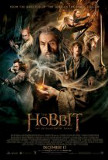Hobbit, The: The Desolation of Smaug (United States/New Zealand, 2013)
December 11, 2013
Special effects have always played an important role in Peter Jackson's adaptations of J.R.R. Tolkien's books but, with The Desolation of Smaug, the middle chapter of The Hobbit movie trilogy, they take center stage. This isn't necessarily a positive development because it comes at the expense of things many film-goers value, like character development and narrative thrust. Filmed and exhibited primarily in 3-D with lengthy computer-created action sequences, The Desolation of Smaug often looks and feels more like a video game than a motion picture. There are things to like about the second Hobbit film - the director's vision of Middle Earth is as beguiling as ever - but the bloating that was a problem with An Unexpected Journey is an even bigger issue here.
The Desolation of Smaug is too long and too visually busy to be loved by any but a die-hard fan. Purists - those who treat Tolkien's written word with Biblical reverence - may be horrified. A lot of the running around that consumes the running time bears no resemblance to anything in the books. Although Jackson doesn't change the core story, he treats it like an outline. Less than 50% of what's on screen during the course of The Desolation of Smaug comes from The Hobbit. The rest is culled from Tolkien's notes and Jackson's imagination.
The film picks up where its predecessor left off, with hobbit Bilbo Baggins (Martin Freeman), wizard Gandalf (Ian McKellan), and 13 dwarves led by Thorin Oakenshield (Richard Armitage), continuing their great adventure. After the confrontation with Azog the Defiler that ended An Unexpected Journey, the group encounters a shape-shifting giant of a man named Beorn. They spend the night in his house before entering Mirkwood Forest where giant spiders and unhelpful elves await. After negotiations between Thorin and the Elf King Thranduil (Lee Pace) prove ineffective, Bilbo helps the dwarves escape their captivity. With orcs in pursuit, they continue their journey to The Lonely Mountain, where Smaug the dragon (voice of Benedict Cumberbatch) awaits. Meanwhile, Gandalf, having separated from the main party, pays a visit to Dol Guldur, the castle of the Necromancer, and learns that Sauron has returned to Middle Earth and is preparing for war.
One evident improvement over An Unexpected Journey relates to pacing. This movie doesn't bog down the way the previous one did. It shifts from one action sequence to the next, sometimes without taking time to breathe. Unfortunately, Jackson's overreliance on computer-generated imagery during many of these high-octane sequences diminishes the experience. Action works best when there's an identification with the characters and a real sense of danger. Those elements are absent here. Many of The Desolation of Smaug's high profile sequences feel either like elaborate video game cut-scenes or templates for an amusement ride. An example is the barrel escape, which feels like a hyper-real animated sequence. By spending so much time extending action sequences (there's one in the bowels of The Lonely Mountain that lasts for 30 minutes), Jackson is forced to end the film on a cliffhanger. It's an awkward stopping point that may anger some viewers.
Admittedly, the dragon looks great - quite an achievement, especially when seen in its full glory on the big screen. Benedict Cumberbatch provides Smaug's voice (giving him an opportunity to interact with Sherlock co-star Martin Freeman) with appropriate gravitas. Still, what was a high point becomes distended for no purpose other than to highlight the technical proficiency of the special effects wizards. The movie's look is odd; color is so desaturated during the second half that there are times when The Desolation of Smaug appears monochromatic. And Howard Shore's normally praiseworthy score is disappointingly flat.
Fans of The Lord of the Rings will welcome the return of Legolas (Orlando Bloom). Although he is not mentioned by name in Tolkien's book, this is an example of effective artistic license. The same can be said of the inclusion of Tauriel (Evangeline Lilly), a creation of screenwriters Fran Walsh, Philippa Boyens, and Peter Jackson. Tauriel at least gives The Desolation of Smaug a female presence and her character arc, limited though it may be, is intriguing. The best new addition to The Desolation of Smaug is Bard the Lake Town hero (Luke Evans), whose story has been expanded beyond the one provided by Tolkien.
As spectacles go, The Desolation of Smaug delivers, at least in its ability to provide eye candy. It fails to excite on a deeper level, however, lacking the emotional impact delivered by The Fellowship of the Ring, The Two Towers, and The Return of the King. It's epic fantasy for those who thinks the term means monsters, chases, fights, and little else. One can argue that it's unfair to judge the middle chapter of a trilogy until all three volumes are available, but Jackson hasn't done an especially good job of making The Desolation of Smaug work as a stand-alone project. Like the dragon's treasure hoard, it's pretty and vast but lacking in substance.
Hobbit, The: The Desolation of Smaug (United States/New Zealand, 2013)
Cast: Martin Freeman, Ian McKellan, Richard Armitage, Luke Evans, Orlando Bloom, Evangeline Lilly, Lee Pace, Stephen Fry, Benedict Cumberbatch (voice)
Screenplay: Fran Walsh & Philippa Boyens & Peter Jackson & Guillermo del Toro, based on the novel by J.R.R. Tolkien
Cinematography: Andrew Lesnie
Music: Howard Shore
U.S. Distributor: Warner Brothers
U.S. Release Date: 2013-12-13
MPAA Rating: "PG-13" (Violence)
Genre: FANTASY/ADVENTURE
Subtitles: none
Theatrical Aspect Ratio: 2.35:1
- Hobbit, The: The Battle of the Five Armies (2014)
- Black Panther (2018)
- Pirates! Band of Misfits, The (2012)
- Da Vinci Code, The (2006)
- Cats (2019)
- (There are no more worst movies of Ian McKellan)
- Hobbit, The: The Battle of the Five Armies (2014)
- Last Days in Vietnam (2014)
- Hobbit, The: An Unexpected Journey (2012)
- Ocean's Eight (2018)
- (There are no more worst movies of Richard Armitage)

Comments